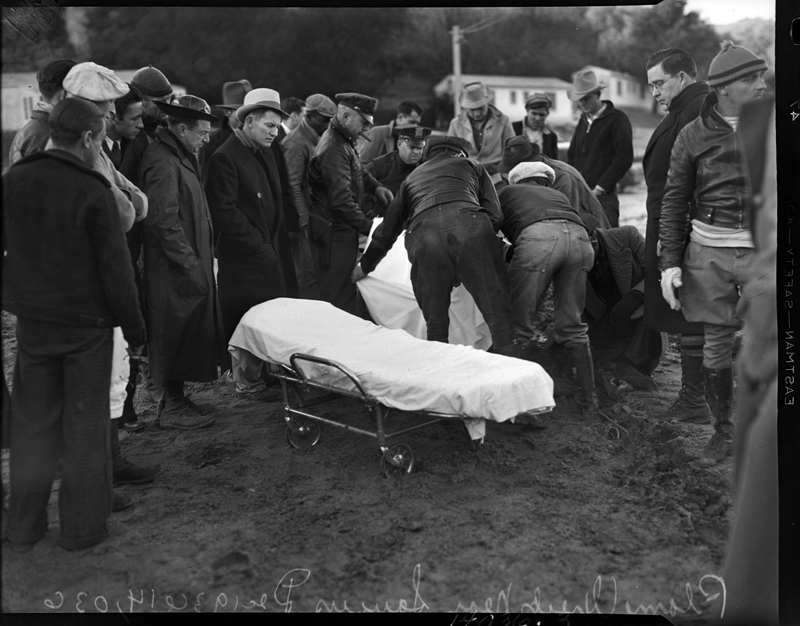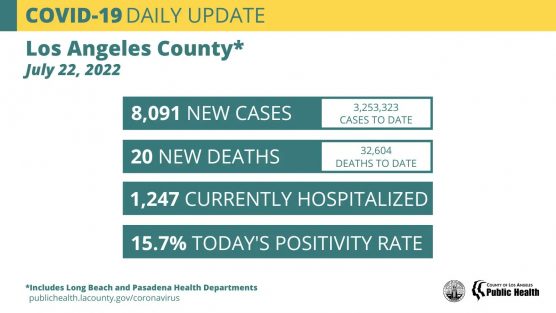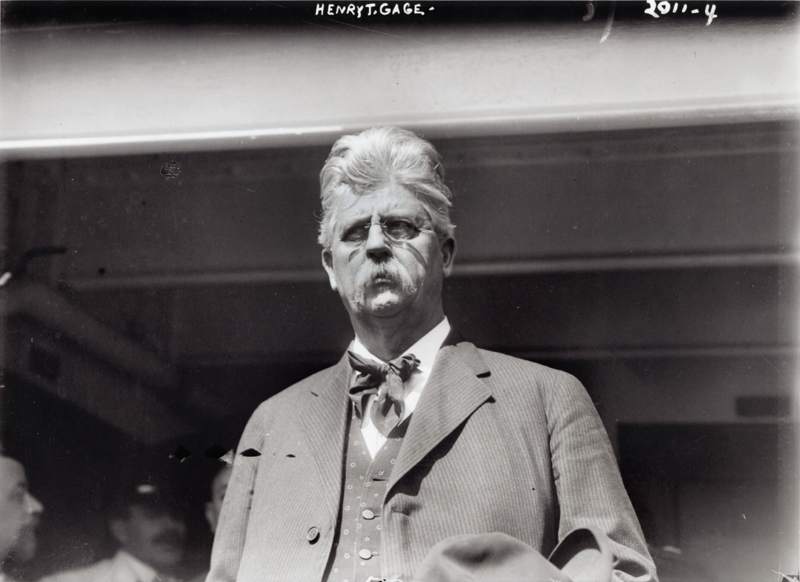The Los Angeles County Department of Public Health confirmed 20 new deaths throughout L.A. County, 8,091 new cases countywide and 241 new cases in the Santa Clarita Valley.
This new data brings Los Angeles County death totals to 32,604, county case totals to 3,253,323 and Santa Clarita Valley case totals to 85,364, with 483 total SCV deaths from COVID-19 since March of 2020.
There are 1,247 people with COVID-19 currently hospitalized. Testing results are available for more than 12,297,229 individuals, with 24% of people testing positive.
Of the 20 new deaths reported today, one person was between the ages of 18-29, three people were between the ages of 30-49, six people were between the ages of 65-79, and eight people were aged 80 years or older. For information on the one death reported by the City of Long Beach and the one death reported by the City of Pasadena, visit longbeach.gov and pasadena.net. Of the 20 newly reported deaths, 16 had underlying health conditions.
Today’s positivity rate is 15.7%.
L.A. County Remains in High COVID-19 Community Level
Los Angeles County remains in the CDC designated High Community Level this week with the rate of new COVID hospital admissions increasing to 11.4 admissions per 100,000 people. The 7-day case rate also increased this past week by 30%; at 481 cases per 100,000 people, this is higher than the case rate in February during the Omicron winter surge.
While some of those infected experience only mild illness, many do not, and we see this in the doubling of emergency department visits for COVID over the last two months. We also see this in staffing shortages at worksites, including at healthcare facilities. Outbreaks at workplaces are disruptive and expensive since there is cost associated with covering shifts and preventing further spread. Households with infected members also suffer disruptions: for some, this includes lost wages, difficulties isolating, and needing help caring for children.
High community transmission also leads to preventable, avoidable deaths, primarily among those most vulnerable. Nearly 4,500 people have already died from COVID this year. If we can slow down transmission, we have a chance at preventing some people from dying in the upcoming months.
It is also clear that many individuals infected with COVID have experienced long COVID, and with big increases in cases, there are likely to be more people reporting illness symptoms weeks after initial infection. The most common symptoms reported for Long COVID are fatigue and exercise intolerance, however breathing problems, brain fog, prolonged loss of taste and smell, and even sudden hair loss have occurred for some. The symptoms vary and may last or reappear over time.
High transmission has been fueled by increased circulation of BA.5, a sub-variant that is associated with high rates or reinfections. Given the results from a recent large study among veterans that identified increased risks to health created by repeat infections, slowing spread is likely to also help lower the risk of reinfections.
Being up-to-date on vaccinations offers the best chance of not experiencing the worst outcomes. Vaccines and boosters continue to significantly reduce the risk of severe disease and death from COVID, should residents become infected. If residents have underlying health conditions or are an older adult, they should be prepared to seek treatment right away if they become sick with COVID. There are free, lifesaving-medications available to treat residents should they become infected and sick.
At home, and in the community, there are several steps residents can take to lower risk, including getting tested if sick or recently exposed, and isolating away from others if they tested positive. When out and about, don’t wait for a masking requirement before masking indoors. If planning to attend a private event, residents should test themselves before going and stay home if they test positive. When hosting an event, it makes sense when transmission is this high to ask others to test before attending. Outside remains safer than inside for parties and events. If gatherings do move indoors, increasing ventilation and masking indoors when not actively eating or drinking is sensible, especially if anyone with vulnerable health is attending.
At workplaces, maximizing ventilation is primary as it reduces the amount of virus in the air, should an infected person be present. Workplaces must provide medical grade masks and/or respirators and may choose to require indoor masking. Workplaces that are experiencing outbreaks have additional reporting, masking, testing, and return to work required measures.
“I send my deepest sympathies and wishes of peace and comfort to the many families who have lost a loved one from COVID-19,” said Barbara Ferrer, PhD, MPH, MEd, Director of Public Health. “What we have learned over the course of the pandemic is that this is a dangerous virus. We benefit enormously for all the effective tools at hand, and they allow most of us to fully live our lives: we travel, we go to parties, we enjoy concerts, plays and sporting events, and we get together with those we love. However, when transmission is really high, we would be foolish to be complacent and not layer in additional protections that help those most vulnerable also fully live their lives. We are a wonderful county, with amazing people and have a long history of working together to protect each other.”
A wide range of data and dashboards on COVID-19 from the Los Angeles County Department of Public Health are available on the Public Health website at http://www.publichealth.lacounty.gov.
To keep workplaces and schools open, residents and workers are asked to:
– Get tested to help reduce the spread, especially if you traveled for the holidays, have had a possible exposure, or have symptoms, or are gathering with people not in your household
– Adhere to masking requirements when indoors or at crowded outdoor spaces, regardless of vaccination status
– Residents are legally required to be isolated if they have a positive COVID test result and vaccinated close contacts with symptoms and unvaccinated close contacts need to be quarantined.
For information on where you can get tested, please visit www.covid19.lacounty.gov/testing/.
For updated isolation and quarantine guidance, please visit www.publichealth.lacounty.gov.
COVID-19 vaccines are safe and effective and are recommended for everyone 5 years old and older to help protect against COVID-19. Vaccinations are always free and open to eligible residents and workers regardless of immigration status. Appointments are not needed at all Public Health vaccination sites and many community sites where first, second, and third doses are available.
To find a vaccination site near you, or to make an appointment, please visit:
www.VaccinateLACounty.com (English) or
www.VacunateLosAngeles.com (Spanish).
William S. Hart Union High School District COVID-19 Dashboard
The William S. Hart Union High School District provides ongoing information to our community regarding COVID-19 cases while maintaining confidentiality for our students and staff. The COVID-19 case data below is updated regularly to indicate any currently confirmed COVID-19 positive case in staff members or students by school site. The data below is specific to individuals who have been physically present on a District campus within 14 days of receiving a positive COVID-19 test. The District, in conjunction with the Los Angeles County Department of Public Health, conducts contact tracing and directly notifies and provides resources for parents of students identified as close contacts (6 feet or less for 15 cumulative minutes or more).
Note: To see the communication process in the event of a positive COVID-19 case, visit https://www.hartdistrict.org/apps/pages/covid-19dashboard.
Schools Community Dashboard

Student Dashboard

Staff Dashboard

Santa Clarita Valley Friday Update
As of 4 p.m. Friday, the L.A. County Public Health dashboard reported no additional deaths in the city of Santa Clarita, leaving the total number of deaths from COVID-19 in the SCV at 483.
The following is the community breakdown per L.A. County’s dashboard:
Santa Clarita: 393
Castaic: 31
Acton: 17
Stevenson Ranch: 15
Unincorporated Canyon Country: 9 (revised from 10)
Agua Dulce: 6
Val Verde: 3 (revised from 4)
Valencia: 2
Unincorporated Bouquet Canyon: 2
Elizabeth Lake: 2
Newhall: 1
unincorporated Saugus/Canyon Country: 1
Lake Hughes: 1
SCV Cases
Of the 85,364 cases reported to Public Health for the SCV to date, the community breakdown is as follows:
Santa Clarita: 62,987
Castaic: 8,646
Stevenson Ranch: 5,031
Canyon Country (unincorporated portion): 3,097
Acton: 1,700
Val Verde: 941
Agua Dulce: 879
Valencia (unincorporated portion west of I-5): 813
Saugus (unincorporated portion): 379
Elizabeth Lake: 237
Bouquet Canyon: 174
Lake Hughes: 177
Saugus/Canyon Country: 103
Newhall (Unincorporated portion): 92
Sand Canyon: 53
San Francisquito/Bouquet Canyon: 38
Placerita Canyon: 17
*Note: The county is unable to break out separate numbers for Castaic and PDC/NCCF because the county uses geotagging software that cannot be changed at this time, according to officials. Click here for the LASD COVID-19 dashboard.
California Friday
The California Department of Public Health now updates their numbers on Tuesday and Friday. The information below is from the most recent data released Friday, July 22.

– 78,476,295 total vaccines administered.
– 79.6% of the eligible population (5+) has been vaccinated with at least one dose.
– 43,435 people a day are receiving COVID-19 vaccination (average daily dose count over 7 days).
Cases
– California has 9,804,803 confirmed cases to date.
– Friday’s average case count is 18,311 (average daily case count over 7 days).
– Unvaccinated people are 5.9 times more likely to get COVID-19 than boosted individuals (June 27, 2022 – July 3, 2022).
Testing
– The testing positivity rate is 16.4% (average rate over 7 days).
Hospitalizations
– There are 4,711 hospitalizations statewide.
– There are 552 ICU patients statewide.
– Unvaccinated people are 7.1 times more likely to be hospitalized than boosted individuals (June 27, 2022 – July 3, 2022).
Deaths
– There have been 92,469 COVID-19 deaths since the start of the pandemic.
– COVID-19 claims the lives of 23 Californians each day (average daily death count over 7 days).
– Unvaccinated people are 9.9 times more likely to die than boosted individuals (June 20, 2022 – June 26, 2022).
Health Care Workers
As of July 21, local health departments have reported 172,748 confirmed positive cases in health care workers and 583 deaths statewide.
Testing Turnaround Time
The testing turnaround time dashboard reports how long California patients are waiting for COVID-19 test results. During the week of July 10 to July 16, the average time patients waited for test results was 0.9 day. During this same time period, 86% of patients received test results in one day and 97% received them within two days.
Multisystem Inflammatory Syndrome in Children (MIS-C)
As of July 18, there have been 1,007 cases of Multisystem Inflammatory Syndrome in Children (MIS-C) reported statewide. MIS-C is a rare inflammatory condition associated with COVID-19 that can damage multiple organ systems. MIS-C can require hospitalization and be life threatening.
Additional Updates
Mask Guidance: Under California’s mask guidance, universal masking is required only in specified higher risk settings like hospitals, public transit and congregate living facilities. Unvaccinated persons are required to mask in all indoor public settings. Fully vaccinated individuals are recommended to continue indoor masking when the risk may be high. Workplaces will continue to follow the COVID-19 prevention standards set by CalOSHA. Local health jurisdictions may implement requirements that are stricter than state guidance.
Slow the Spread: Get Vaccinated and Boosted for COVID-19
The risk for COVID-19 exposure and infection continues as a number of Californians remain unvaccinated and unboosted.
Real-world evidence continues to show that the vaccine is preventing severe illness, hospitalization, and death. Public health officials urge Californians to get vaccinated and boosted as soon as possible.
It is recommended that every individual six months of age and older receive their primary COVID-19 vaccine series and booster dose.
It is recommended that every vaccinated person 12 years or older should get a booster as long as they received their second dose of the Pfizer or Moderna vaccine at least five months ago or they received their Johnson & Johnson vaccine at least two months ago.
Vaccination appointments can be made by visiting myturn.ca.gov or calling 1-833-422-4255. The consent of a parent or legal guardian may be needed for those under age 18 to receive a vaccination. Visit Vaccinate All 58 to learn more about the safe and effective vaccines available for all Californians 5+.
Your Actions Save Lives
Protect yourself, family, friends and your community by following these prevention measures:
Keep California Healthy
Protect yourself, family, friends and your community by following these prevention measures:
– Get vaccinated when it’s your turn. Californians age 16+ are eligible to make an appointment.
– If you are experiencing symptoms of COVID-19 (fever, cough, shortness of breath, fatigue, muscle or body aches), call your health care provider.
– If you believe you have been exposed, get tested. Free, confidential testing is available statewide.
– Keep gatherings small and outdoors and follow state and local public health guidance.
– Wear a mask and get the most out of masking – an effective mask has both good fit and good filtration.
– Wash hands with soap and water for at least 20 seconds.
– Delay non-essential travel outside of California until you are fully vaccinated. Follow California’s travel advisory.
– Avoid close contact with people who are sick and stay home from work and school if you feel ill.
– Add your phone to the fight by signing up for COVID-19 exposure notifications from CA Notify.
– Answer the call or text if a contact tracer from the CA COVID Team or your local health department tries to connect.
Additional data and udpates:
Tracking COVID-19 in California
State Dashboard – Daily COVID-19 data
County Map – Local data, including tier status and ICU capacity
Data and Tools – Models and dashboards for researchers, scientists, and the public
Blueprint for a Safer Economy– Data for establishing tier status
COVID-19 Race & Ethnicity Data – Weekly updated Race & Ethnicity data
Cases and Deaths by Age Group – Weekly updated Deaths by Age Group data
Health Equity Dashboard – See how COVID-19 highlights existing inequities in health
Tracking Variants – Data on the variants California is currently monitoring
Safe Schools for All Hub – Information about safe in-person instruction
School Districts Reopening Map – data on public schools and reported outbreaks
Always check with trusted sources for the latest accurate information about novel coronavirus:
– Los Angeles County Department of Public Health
– California Department of Public Health
– Centers for Disease Control and Prevention
– Spanish
– World Health Organization
L.A. County residents can also call 2-1-1.
What to Do if You Think You’re Sick
Call ahead: If you are experiencing symptoms of COVID-19 (fever, cough or shortness of breath), call your health care provider before seeking medical care so that appropriate precautions can be taken. More than 85 community testing sites also offer free, confidential testing: Find a COVID-19 Testing Site.
For more information about what Californians can do to prevent the spread of COVID-19, visit Coronavirus (COVID-19) in California.
California continues to issue guidance on preparing and protecting California from COVID-19. Consolidated guidance is available on the California Department of Public Health’s Guidance webpage.

Like this:
Like Loading...
Related





 Tweet This
Tweet This Facebook
Facebook Digg This
Digg This Bookmark
Bookmark Stumble
Stumble RSS
RSS































REAL NAMES ONLY: All posters must use their real individual or business name. This applies equally to Twitter account holders who use a nickname.
0 Comments
You can be the first one to leave a comment.